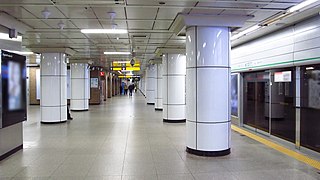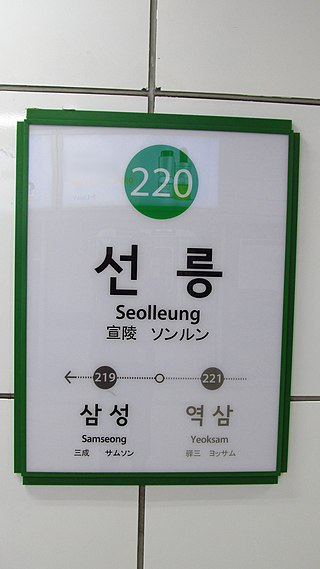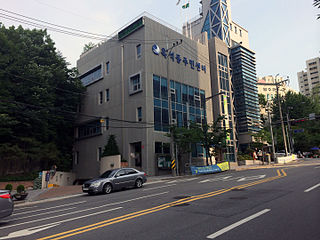
Sadang Station is a station on the Seoul Subway Line 2 and Seoul Subway Line 4 in South Korea.

Sillim Station is a station on Seoul Subway Line 2 and the Sillim Line. It is located in Sillim-dong, Gwanak-gu, Seoul.

Yeongdeungpo District is an administrative district in southwest Seoul, South Korea. Although the origin of the name is uncertain, the first two syllables are thought to be from "yeongdeung" (靈登) or "divine ascent", a shamanic rite. The third syllable is "po", representing the bank of a river (浦), referring to the district's position on the Han River. The 2006 population was 408,819.

Gwanak District is an administrative subdivision (gu) of Seoul, South Korea. It lies on the southern skirt of Seoul, bordering Anyang of Gyeonggi Province. The southern border of Gwanak District, bordering Anyang, consists of the craggy ridgeline of Gwanaksan, which dominates the local geography.

Seolleung Station is a Seoul Subway station that serves Line 2 and the Suin–Bundang Line. The station is named after the nearby Seonjeongneung, Joseon Dynasty royal tombs Seolleung and Jeongneung.

Seocho District is one of the 25 local government districts which make up the city of Seoul, South Korea. Seocho is a part of the Gangnam region, along with the Gangnam district of Seoul. Seocho District ranks as one of the richest neighborhoods in South Korea and among the most expensive areas in Seoul with an average sales price of 47.75 million South Korean won per 3.3 square meters. Many of the wealthiest residents are concentrated in the three Gangnam districts including Seocho, known as Gangnam School District Eight.

Dongjak District (Korean: 동작구) is one of the 25 gu (districts) that make up the city of Seoul, South Korea. Its name was derived from the Dongjaegi Naruteo Ferry, on the Han River which borders the district to the north. It was the 17th gu created in Seoul, after being separated from Gwanak District on 1 April 1980.

Jamsil Station is an underground station on Line 2 and Line 8 of the Seoul Metropolitan Subway. Lotte World is continuous with the Line 2 station. The station is also called Songpa-gu Office Station (송파구청역), due to the proximity of the office building.

Bupyeong District is one of the 10 administrative divisions that comprise Incheon, South Korea. Bupyeong District comprises an area of 12.35 square miles, and has a population of 508,587. It is located north of Namdong District, east of Seo District, and south of Gyeyang District. The city of Bucheon, in neighboring Gyeonggi Province, comprises its eastern limit.
Bon-dong is a dong (neighborhood) of Dongjak District, Seoul, South Korea.

Heukseok-dong (Korean: 흑석동) is a dong (neighborhood) of Dongjak District, Seoul, South Korea.
Noryangjin-dong is a dong (neighborhood) of Dongjak-gu in Seoul, South Korea.
Sangdo-dong (Korean: 상도동) is a dong, neighbourhood of Dongjak District in Seoul, South Korea.
Sindaebang-dong is a dong, neighbourhood of Dongjak-gu in Seoul, South Korea.

Banghwa-dong is a dong, neighborhood of Gangseo District, Seoul in Seoul, South Korea.

Sillim-dong (Korean: 신림동) is a dong (neighborhood) of Gwanak District, Seoul, South Korea. Seoul National University and Nokdu Street are located in the town. Its name means "new forest", which was derived from the woods outstretched from Mt. Gwanak. It consists 11 administrative neighbourhoods.

Sungin-dong is a dong, neighbourhood of Jongno-gu in Seoul, South Korea.

Noryangjin Fisheries Wholesale Market or shortly Noryangjin Fish Market is an extensive farmers fish market in the neighborhood of Noryangjin-dong in Dongjak District, Seoul, South Korea. It is located east of 63 Building, and just south of the Han River. Metro line 1 passes through at Noryangin station near-by. Exit the station at exit 1 and walk under the bridge. It is open 24/7.

Sindang-dong (Korean: 신당동) is a dong, neighbourhood of Jung-gu in Seoul, South Korea.
Songjeong-dong is a dong (neighborhood) of Seongdong-gu in Seoul, South Korea.
















